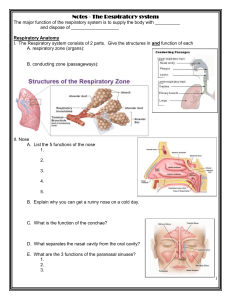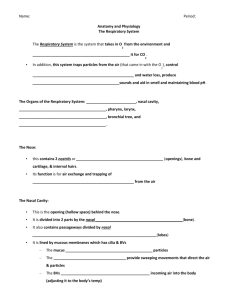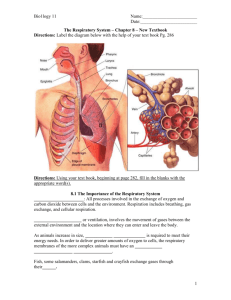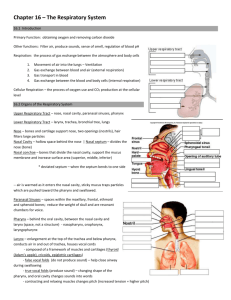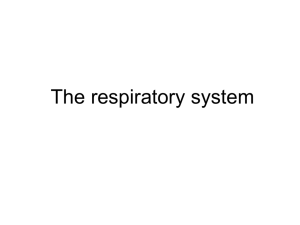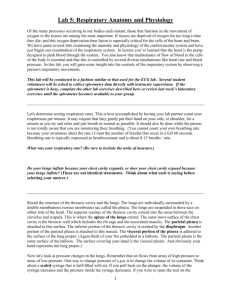Respiratory
advertisement
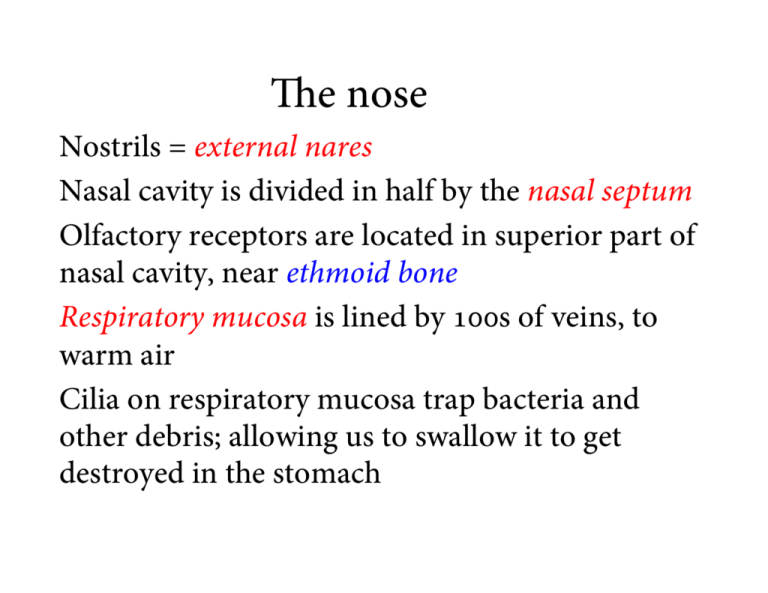
The nose Nostrils = external nares Nasal cavity is divided in half by the nasal septum Olfactory receptors are located in superior part of nasal cavity, near ethmoid bone Respiratory mucosa is lined by 100s of veins, to warm air Cilia on respiratory mucosa trap bacteria and other debris; allowing us to swallow it to get destroyed in the stomach Nasal conchae Increase surface area and air turbulence in nasal cavity Increases trapping of debris on mucus-covered surfaces Increases efficiency of air warming Nasal cavity anatomy Pharynx = your throat Continuous with nasal cavity via the internal nares Divided into nasopharynx, oropharynx, and laryngopharynx, which enters the larynx Pharyngotympanic tubes empty into nasopharynx Pharynx is the side of several clusters of lymphatic tissue (= tonsils) Larynx Inferior to pharynx Formed of 8 rigid hyaline cartilages and the epiglottis (elastic cartilage) Thyroid cartilage protudes anteriorly, forming the Adam’s Apple Epiglottis closes over the trachea when we swallow, preventing anything but air going into the airways Folds in mucus membrane form the vocal folds, which vibrate, allowing us to speak Trachea Extends from pharynx to about mid-chest (5th thoracic vertebrae) Reinforced by C-shaped rings of hyaline cartilage abut the esophagus, allowing it to expand keep the airway patent (= open) Lined with cilia that beat away from the lungs, further filtering out debris, etc. The lungs Respiratory zone structures Respiratory zone is the only site of gas exchange in the lungs; all other structures are part of conducting zone Respiratory membrane Pulmonary surfactants Essential for proper functioning of the lungs Lowers surface tension of the film of water lining alveoli, keeping them from collapsing Not present until babies are 28-30 weeks old Pulmonary ventilation = breathing Process depends on pressure changes in the thoracic cavity Gas particles always fill their container if there are few gas particles, pressure is low If there are many gas particles, pressure will be high Breathing consists of two phases: inspiration, and expiration Inspiration Diaphragm and external intercostal muscles contract, increasing size of thoracic cavity Lungs increase volume with the thorax Interpulmonary volume increases, decreasing gas pressure within the lungs This partial vacuum sucks air into the lungs from the outside Air moves into lungs until pressure inside and outside of lungs is equal Expiration Inspiratory muscles relax Intrapulmonary volume decreases, pressure increases Gases equalize pressures Intrapleural pressure is always negative--prevents lungs from collapsing Respiratory volumes and capacities Gas exchange Control of respiration Respiratory muscles are controlled by the phrenic and intercostal nerves The medulla sets the basic breathing rhythm, and contains the self-exciting inspiratory center The pons is responsible for smoothing that basic breathing pattern Normal respiratory rate (12-15 resps/min) = eupnea Respiratory influences Physical factors Talking, coughing, exercising all modify the rate and depth of our breaths; increased body temperature also increases the rate of breathing Emotional factors Gasping, laughing, crying Respiratory influences Volition (conscious control) We can control the rate of breathing to some control (i.e. holding our breath), but respiratory centers will eventually ignore messages from the cortex Chemicals Levels of CO2 (medulla) and O2 (carotid body and arch) in the blood affect respiratory rate. Decreased pH.


